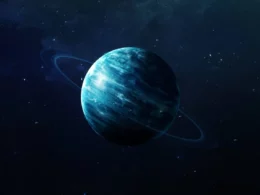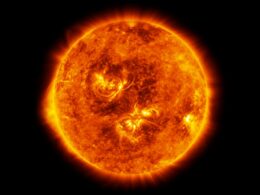Pluto, once considered the ninth planet in our Solar System, is now classified as a dwarf planet. It is located in the Kuiper Belt, a region beyond Neptune that is home to numerous icy objects. Despite its small size, Pluto has been the subject of much scientific study and fascination. One of the most interesting aspects of Pluto is its day length.
A day on Pluto is not like a day on Earth. While it takes Earth 24 hours to complete one rotation, it takes Pluto about 6.4 Earth days to complete one rotation. This means that a day on Pluto is about 153 hours long. This is due to Pluto’s slow rotation and its distance from the Sun. Because it is so far from the Sun, Pluto receives very little sunlight, which means that its surface is extremely cold.
Pluto’s Rotation and Orbit
Understanding a Day on Pluto
Pluto is a dwarf planet located in the Kuiper Belt, a region of the Solar System beyond Neptune’s orbit. One of the most interesting features of Pluto is its rotation and orbit. A day on Pluto is much longer than a day on Earth. It takes 6.4 Earth days (6 days 9 hours and 36 minutes) for Pluto to complete one rotation on its axis. This means that a day on Pluto is much longer than a year on Pluto.
Orbital Characteristics and Rotation Period
Pluto’s orbit around the sun is quite unusual compared to the other planets in the Solar System. According to NASA Science, Pluto’s 248-year-long, oval-shaped orbit can take it as far as 49.3 astronomical units (AU) from the sun, and as close as 30 AU. One AU is the mean distance between Earth and the Sun, which is about 93 million miles or 150 million kilometers. Pluto’s axis of rotation is tilted 57 degrees with respect to the plane of its orbit.
Pluto’s rotation is also unique. It rotates in a retrograde direction, which means it rotates from east to west, opposite to the direction of its orbit around the sun. This is opposite to the rotation of most planets in the Solar System. The reason for this is not fully understood, but it is believed to be due to a collision with another object in the Kuiper Belt.
Pluto is also known for its large moon, Charon. The two objects are sometimes referred to as a double planet because they are similar in size. Charon is tidally locked with Pluto, which means it always shows the same face to Pluto. This is similar to the way the Moon is tidally locked with Earth.
In terms of its physical characteristics, Pluto has a radius of about 1,476 miles (2,377 kilometers), which is about 18.5% of Earth’s radius. It has a very thin atmosphere and a density that is slightly higher than water. Pluto’s mass is only about 0.002 times that of Earth.
Physical and Geological Features
Surface Composition and Climate
Pluto is a dwarf planet located in the Kuiper Belt, and it has a tenuous atmosphere that is mostly composed of nitrogen, with traces of methane and carbon monoxide. The surface of Pluto is covered with water ice, nitrogen frost, and other volatile compounds. The temperature on Pluto varies from -378 to -396 degrees Fahrenheit (-228 to -238 degrees Celsius), making it one of the coldest places in the solar system.
Pluto’s surface is marked by mountains, craters, plains, and valleys. The largest mountain on Pluto is called Wright Mons, which is about 3.5 kilometers high. The surface of Pluto also contains glaciers made of nitrogen and methane, and it is believed that the dwarf planet may have a subsurface ocean of liquid water.
Geological Activity and Moon Interaction
Pluto is a geologically active world, with evidence of tectonic forces and other geological processes. Its five moons, Nix, Hydra, Kerberos, Styx, and Charon, also play a role in the geological activity of the dwarf planet.
Charon, Pluto’s largest moon, is tidally locked with the dwarf planet, which means that it always shows the same face to Pluto. The gravitational interaction between Pluto and Charon has caused the surface of both worlds to be reshaped by convection, which is the movement of material within the mantle.
Pluto’s other moons, Nix, Hydra, Kerberos, and Styx, are irregularly shaped and have a low density, which suggests that they are composed of a mixture of rock and ice. These moons may have formed from the debris of a collision between Pluto and another icy world in the Kuiper Belt.
Frequently Asked Questions
What is the rotational period of Pluto?
The rotational period of Pluto, also known as its day length, is approximately 6.4 Earth days. This means that it takes 6.4 Earth days for Pluto to complete one full rotation on its axis.
How does Pluto’s day length compare to Earth’s?
Pluto’s day length is much longer than Earth’s day length. While Earth takes approximately 24 hours to complete one full rotation on its axis, Pluto takes 6.4 Earth days to complete one full rotation.
What is the duration of a Pluto solar day?
The duration of a solar day on Pluto is approximately 153.3 Earth hours. This is the amount of time it takes for the Sun to appear at the same position in the sky on Pluto.
What is the difference in day length between Pluto and its moons?
Pluto’s largest moon, Charon, is tidally locked with Pluto, meaning that the same side of Charon always faces Pluto. As a result, Charon’s day length is the same as its orbital period around Pluto, which is 6.4 Earth days. Pluto’s other four moons have shorter day lengths, ranging from 38 hours for Nix to 11.3 Earth days for Hydra.
How does the length of a day on Pluto contrast with that of other planets in the Solar System?
The length of a day on Pluto is much longer than the day lengths of the eight planets in the Solar System. For example, the day length of Mercury, the planet with the shortest day, is approximately 59 Earth days, while the day length of Venus, the planet with the longest day, is approximately 243 Earth days.





